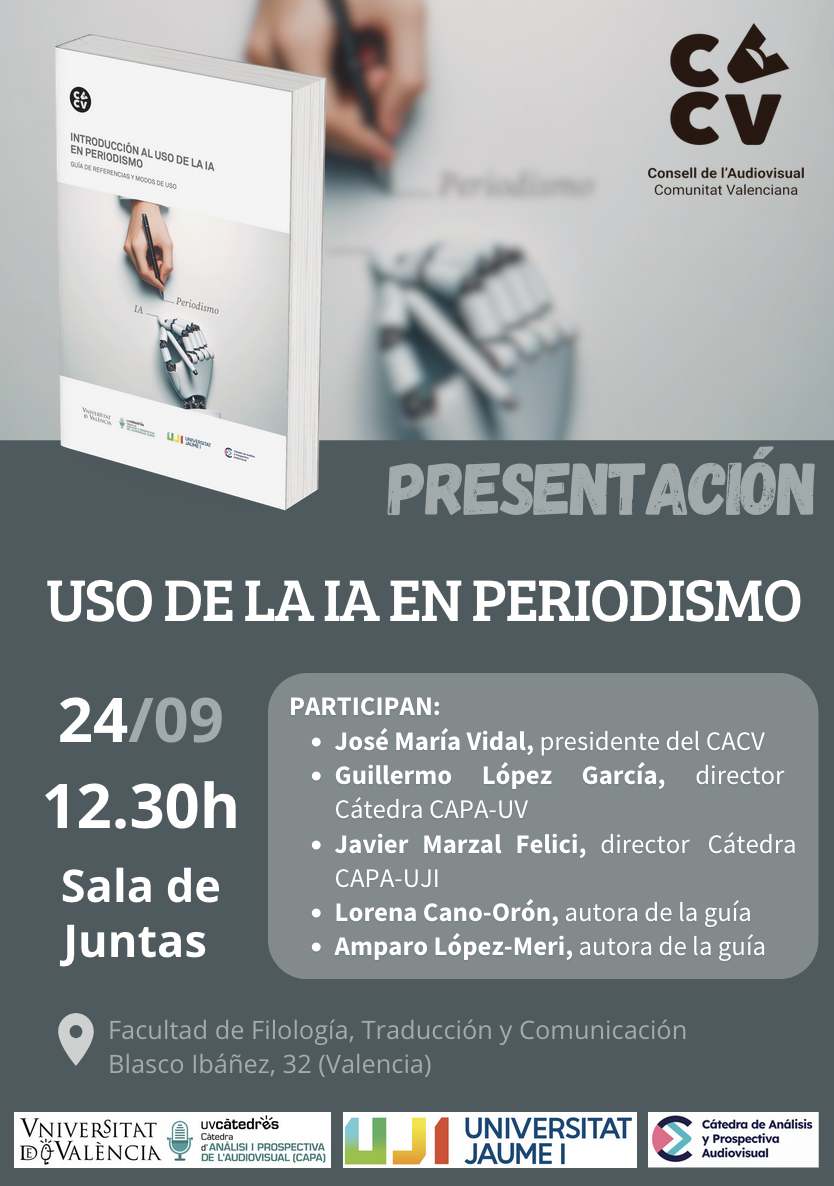Date: 24 September 2024
Place: Boardroom, Faculty of Philology, Translation and Communication, Universitat de València.

24 de setembre de 2024
In an environment in constant transformation where advanced technology improves rapidly, artificial intelligence (IA) has turned into a key tool for different industries, and journalism is not an exception. With the objective to provide and update and practical resource, theChair for Audiovisual Prospects and Analysis (CAPA) and the Universitat Jaume I de Castelló present the manual Introduction to the Use of IA in Journalism. Guide of references in means of use. This guide responds to the growing necessity to adapt the compositions in new technologies, training journalists in the efficient use of the IA.
The presentation ceremony will take place the 24 September, 2024, in the Boardroom of the Faculty of Philology, Translation and Communication in the Universitat de València, and will count with the participation of the following lecturers:
- José María Vidal, President of the Audiovisual Council of the Valencian Community.
- Guillermo López García, Director of the Chair for CAPA-UV.
Javier Marzal Felici, Director of the Chair for CAPA-UJI. - Lorena Cano-Orón, journalism teacher in the Universitat de València and author of the guide.
- Amparo López-Meri, journalism teacher in the Universitat Jaume I de Castelló and author of the guide.
Content of the guide
The manual is structured in four fundamental sections that deal with the basic concepts of the IA until its practical and ethics application in journalism:
- Tendencies on the present use of IA in composition: This section offers an exhaustive vision about how the IA is transforming media, highlighting real cases and tendencies in a national and international level.
- Guidance of the application of IA in the production of contents: Applicable tools are explored in all the phases of the creation of content, from the pre-production to the distribution. Including practical tutorials that help journalist to improve the efficiency and quality of work using IA.
- Use IA from ethics: challenges and recommendations: They deal with ethic challenges associated with the use of IA in journalism, with recommendations for a responsible and alienated use with the fundamental principles of the profession.
- Additional resources: It is offered a selection of materials for those that want to go further in the knowledge and use of the IA in journalism, allowing professionals to be up to date on the latest tendencies and technologies.
A balanced approach
The guide puts emphasis in that the artificial intelligence has to be seen as a complementary tool, not as a substitute of the human work. The applications of the IA can improve the productivity and quality of the content, but also present ethical challenges, such as data biases and transparency of processes. Because of this, the work defends a well-balance use that combines innovative technology with journalist ethic.
In addition, detailed tutorials are included so journalist can apply directly the learned concepts, for example the automatic transcription by voice to text, the detection of tendencies, the verification of sources and generation of content with tools like ChatGPT. These tutorials are accessible for journalists of all levels of experience.

Guia de referències i medis d'ús". (clica per accedir al manual)




